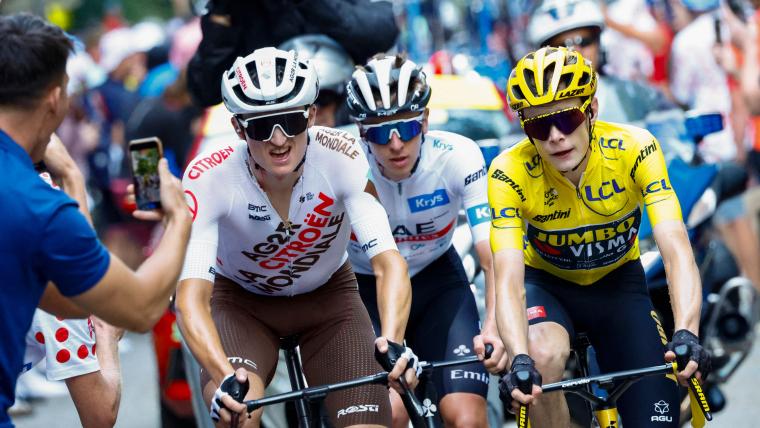
The 111th edition of the Tour de France is finally here as the world’s best road cyclists battle it out once again for the famous yellow jersey.
Starting Saturday, June 29, in Florence, Italy, and ending three weeks later on Sunday, July 21, in Nice, France, the group of riders will total 3,492km (2,170-mile).
Among the 22 teams competing are a host of talented riders all looking to leave their mark — Tadej Pogacar (UAE Team Emirates) goes in pursuit of the Giro-Tour double, while Jonas Vingegaard (Visma-Lease a Bike) is the man tasked with defending his Tour title.
The Sporting News is tracking the results from the 2024 Tour de France. Follow along with the stages below.
Tour de France standings 2024
General classification through Stage 4
| Pos. | Cyclist (Nationality) | Time | Back |
| 1. | Tadej Pogacar (SLO) | 23:15.24 | — |
| 2. | Jonas Vingegaard (DEN) | 23:16.09 | +00:00.45 |
| 3. | Juan Ayuso (ESP) | 23:16.14 | +00:00.50 |
| 4. | Primoz Roglic (SLO) | 23:16.34 | +00:01.10 |
| 5. | Carlos Rodriguez (ESP) | 23:16.38 | +00:01.14 |
MORE: Tour de France 2024: Full schedule, stages, route, length, TV channel & live stream
Tour de France 2024 winners, results by stage
The 2024 Tour de France begins Saturday, June 29, in Florence, Italy, and lasts until Sunday, July 21, when it finishes Nice, France.
July 8 and July 15 are the riders’ only rest days during the mammoth task of completing the 3,492km (2,170-mile) race.
Follow along with the winners for each stage below.
| Stage | Date | Length | Location (type) | Stage winner |
| 1 | June 29 | 206 km (128 miles) | Florence to Rimini (hilly) | Romain Bardet |
| 2 | June 30 | 199.2 km (123.8 miles) | Cesenatico to Bologna (hilly) | Kevin Vauquelin |
| 3 | July 1 | 230.8 km (143.4 miles) | Piacenza to Turin (flat) | Biniam Girmay |
| 4 | July 2 | 139.6 km (86.7 miles) | Pinerolo to Valloire (mountain) | Tadej Pogacar |
| 5 | July 3 | 177.4 km (110.2 miles) | Saint-Jean-de-Maurienne to Saint-Vulbas (flat) | Mark Cavendish |
| 6 | July 4 | 163.5 km (101.6 miles) | Macon to Dijon (flat) | — |
| 7 | July 5 | 25.3 km (15.7 miles) | Nuits-Saint-Georges to Gevrey-Chambertin (individual time-trial) | — |
| 8 | July 6 | 183.4 km (114 miles) | Semur-en-Auxois to Colombey-les-Deux-Églises (flat) | — |
| 9 | July 7 | 199 km (123.7 miles) | Troyes to Troyes (hilly) | — |
| Rest day | July 8 | — | — | — |
| 10 | July 9 | 187.3 km (116.3 miles) | Orleans to Saint-Amand-Montrond (flat) | — |
| 11 | July 10 | 221 km (137.3 miles) | Evaux-les-Bains to Le Lioran (mountain) | — |
| 12 | July 11 | 203.6 km (126.5 miles) | Aurillac to Villeneuve-sur-Lot (flat) | — |
| 13 | July 12 | 165.3 km (102.7 miles) | Agen to Pau (flat) | — |
| 14 | July 13 | 151.9 km (94.3 miles) | Pau to Saint-Lary-Soulan/Pla d’Adet (mountain) | — |
| 15 | July 14 | 198 km (123 miles) | Loudenvielle to Plateau de Beille (mountain) | — |
| Rest day | July 15 | — | — | — |
| 16 | July 16 | 188.6 km (117.1 miles) | Gruissan to Nimes (flat) | — |
| 17 | July 17 | 177.8 km (110.5 miles) | Saint-Paul-Trois-Chateaux to SuperDevoluy (mountain) | — |
| 18 | July 18 | 179.5 km (111.5 miles) | Gap to Barcelonnette (hilly) | — |
| 19 | July 19 | 144.6 km (89.8 miles) | Embrun to Isola 2000 (mountain) | — |
| 20 | July 20 | 132.8 km (82.5 miles) | Nice to Col de la Couillole (mountain) | — |
| 21 | July 21 | 33.7 km (20.9 miles) | Monaco to Nice (individual time-trial) | — |
What do the Tour de France jerseys mean?
There are four jerseys given to riders during the Tour de France, marking overall leaders and winners of certain classifications.
Yellow jersey
The yellow jersey is worn by the aggregate time leader at the beginning of a stage. For example, if one rider has the best time through three stages, he will wear the yellow jersey for the fourth stage. That means the winner of the Tour de France after all 21 stages always receives the yellow jersey, or the maillot jaune.
Polka dot jersey
The polka dot jersey is awarded to the rider who performs the best on the race’s grueling climbs. Known as “King of the Mountains,” the rider receives the jersey based on finishing with the highest number of points assigned from mountaintop checkpoints.
Green jersey
The green jersey is awarded to points classification winners. It’s considered the sprinter’s jersey, as more points are awarded in this case for flat stages. The winner of a flat stage will receive 50 points, whereas the winner of a “hilly” stage receives 30 and the winner of a “high mountain” stage receives 20. The top 15 finishers are traditionally awarded points, and points also can be accumulated during intermediate sprints in the middle of stages.
White jersey
The white jersey is awarded to the best finisher among riders aged 25 or younger. That means riders can win both the white jersey and the yellow jersey, and that’s exactly what Tadej Pogacar did in both 2020 and 2021.






